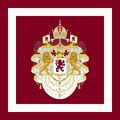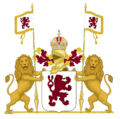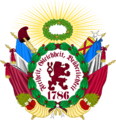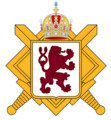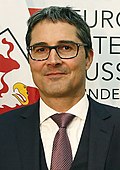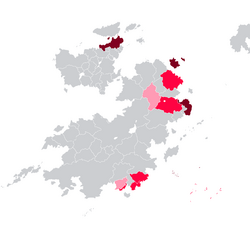User:Britbong64/Sandbox 3: Difference between revisions
Britbong64 (talk | contribs) |
Britbong64 (talk | contribs) |
||
| Line 263: | Line 263: | ||
*1991-1995 - Social Democratic Radical Party majority | *1991-1995 - Social Democratic Radical Party majority | ||
*1991-1995 - Social Democratic Radical Party majority | *1991-1995 - Social Democratic Radical Party majority | ||
*1999-2003 - Social Democratic Radical Party, | *1999-2003 - Social Democratic Radical Party, Centre Party, Green Party Coalition | ||
*2003-2007 - National Consolidation Party, | *2003-2007 - National Consolidation Party, Democratic Homeland coalition | ||
*2007-2011 - National Consolidation Party, Democratic Homeland | *2007-2011 - National Consolidation Party, Democratic Homeland coalition | ||
*2011-2015 - Social Democratic Radical Party, Centre Party coalition | *2011-2015 - Social Democratic Radical Party, Centre Party coalition | ||
*2015-2019 - Social Democratic Radical Party, Centre Party coalition | *2015-2019 - Social Democratic Radical Party, Centre Party coalition | ||
Latest revision as of 01:20, 26 February 2024
Flags
Emblems
Provincial data
- National parties
Cislania
Economy
- GDP - $707,368,664,117; Switzerland}
- GDPpc - $48,888; Finland
- % of national GDP - 28.72%
Politics
- Government - NKP single party with DA/AVP parliamentary support.
- Current term - May 2022 - May 2026
Ruttland
Economy
- GDP - $399,130,274,907; Norway
- GDPpc - $36,981; United Arab Emirates
- % of national GDP - 16.21%
Politics
- Government - NNK majority.
- Current term - January 2021- January 2025
Roetenberg
Economy
- GDP - $356,707,114,470; Philippines}
- GDPpc - $40,635; Japan
- % of national GDP - 14.48%
Politics
- Government - NKP/PMZ coalition.
- Current term - January 2021- January 2025
Wolfsfled
Economy
- GDP - $288,365,574,910; Pakistan
- GDPpc - $38,215; United Arab Emirates
- % of national GDP - 9.07%
Politics
- Government - EO-Green coalition
- Current term - May 2022 - May 2026
Bonnlitz-Ostbrücken
Economy
- GDP - $243,340,840,512; Romania
- GDPpc - $36,432; United Arab Emirates
- % of national GDP - 9.88%
Politics
- Government - SRPO-Green-OSAI coalition
- Current term - January 2021- January 2025
Prizen
Economy
- GDP - $158,904,236,816; Ukraine
- GDPpc - $38,504; United Arab Emirates
- % of national GDP - 6.45%
Politics
- Government - EO minority government
- Current term - May 2022 - May 2026
Elbenweis
Economy
- GDP - $154,759,549,656; Ukraine
- GDPpc - $47,679; San Marino
- % of national GDP - 6.28%
Politics
- Government - Green-EO coalition
- Current term - May 2018 - May 2022
Wittislich
Economy
Politics
- Government - NKP majority
- Current term - January 2021- January 2025
Westbrücken
Economy
- GDP - $69,505,033,392; Luxembourg
- GDPpc - $64,602; Singapore
- % of national GDP - 2.82%
Politics
- Government - SAPO-Greens-OSAI coalition
- Current term - January 2021- January 2025
Kolreuth
Economy
Politics
- Government - EO majority
- Current term - May 2018 - May 2022
Charlotte Island
Economy
- GDP - $1,438,638,680; Solomon Islands
- GDPpc - $14,584; Poland
- % of national GDP - 0.06%
Politics
- Government - TBA
- Current term - May 2022 - May 2026
Federal coalitions
- 1980-1983 - Social Democratic Radical Party, Weranian Section of the Workers' International coalition
- 1983-1987 - Social Democratic Radical Party majority
- 1987-1991 - National Consolidation Party, Centre Party coalition
- 1991-1995 - Social Democratic Radical Party majority
- 1991-1995 - Social Democratic Radical Party majority
- 1999-2003 - Social Democratic Radical Party, Centre Party, Green Party Coalition
- 2003-2007 - National Consolidation Party, Democratic Homeland coalition
- 2007-2011 - National Consolidation Party, Democratic Homeland coalition
- 2011-2015 - Social Democratic Radical Party, Centre Party coalition
- 2015-2019 - Social Democratic Radical Party, Centre Party coalition
- 2019-2023 - National Consolidation Party, Democratic Alternative coalition
- 2023-2027 - National Consolidation Party majority
Decolonisation
1951 federation plan - proposed by the Colonies Minister Elmar Hattendorf and so became known as the Hattendorf plan. The plan aimed to divide the empire into three categories who would have different paths to self-determination.
- Category A colonies were to be integrated into the metropole through the slow expansion of political rights with the intention of eventually becoming equal federal units. The integration of these territories was expected to last for 20-30 years.
- Category B colonies were to hold referendums where they would either vote to be integrated albeit on a longer time scale like Category A colonies or enter a privileged partnership with Werania being governed as associated states.
- Category C colonies were mandates believed by the Weranian government to be temporary and so were to have referendums where they would either endorse an extension of the mandate or enter negotiations for independence.
The Hattendorf plan was a failure with there being widespread riots following its announcement, leading to the Weranian government to scrap it.
Misc
Aldmany
Aldeland | |
|---|---|
Historical region | |
 | |
| Country | |
| Largest cities | |
| Demonym |
|
Dienstmann - Dienstsman. Originally a derogatory term comparing settlers to serfs, it became a term of pride and affection for the settlers. The majority settled on the coast.
Volkstag -> House of Deputies (Abgeordnetenhaus)
Herrstag -> House of Councillors (Ratsmitgliederhaus)
- Herrenhaus -> House of Lords (former upper house)
Trade unions
- Weranian Federation of Workers' (Ostischer Arbeitsverband; OAV) - Council communist, syndicalist (historical)
- Confederation of Catholic Trade Unions (Bund Katholischer Gewerkschaften; BKG) - Christian left
- Weranian Federation of Workers'-Workers' Democracy (Ostischer Arbeitsverband - Arbeiterdemokratie; OAV-AD) - Social democratic
- 1883 general strike
- 1891 general strike
- 1919 general strike
- 1950 general strike
- 1972 general strike
- 2009 public sector strike
Uniforms
- Revolutionary Army - Napoleonic Austrian
- 1842-1930's - k.u.k. Armee (Common Army + Austrian Landwehr)
- 1930's-1950's - Reichwehr/Wehrmacht
- 1950's-present - Bundeswehr
- 1842-1891 - limited suffrage - Single non-transferable vote
- 1891-1911 - universal male suffrage - plural voting - block voting/Single non-transferable vote
- 1911-1935 - universal male suffrage - Single non-transferable vote
- 1935-1960 - universal suffrage - party-list proportional representation
- 1960-present - universal suffrage - parallel voting
Republic
Brotherhood for the Rights of Man Bruderschaft für die Rechte des Menschen | |
|---|---|
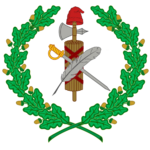 | |
| Leaders | • Franz Xaver Dobrizhoffer • Sigmund Auerswald • Joachim Hochheim • Otto Schönbaum |
| Founded | 1784 |
| Dissolved | 1801 |
| Headquarters | Hochgäu Palace, Westbrücken |
| Newspaper | • Appell des Volkes • Stimme für Rechte |
| Factions | Kreisists Opportunisten |
| Ideology | Cult of Reason Republicanism Radicalism Dirigisme Anticlericalism |
| Political position | Left-wing to far-left |
| Colors | Red |
Society of Friends of the People Gesellschaft der Freunde des Volkes | |
|---|---|
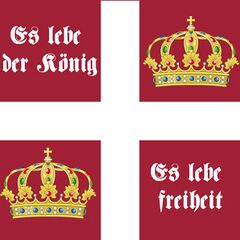 | |
| Leaders | tba |
| Founded | 1784 |
| Dissolved | 1786 |
| Headquarters | Rinder Estate, Westbrücken |
| Newspaper | Volksherold |
| Ideology | Constitutional monarchism Parliamentarianism Classical liberalism |
| Political position | Centre right |
| Colors | Blue |
Supporters of the Assembly Unterstützer der Versammlung | |
|---|---|
| Leaders | Ludwig von Kirchschläger |
| Founded | 1784 |
| Dissolved | 1801 |
| Headquarters | Westbrücken |
| Ideology | Republicanism Political syncretism Technocracy Factions Radicalism Classical liberalism |
| Political position | Centre |
| Colors | Grey |
1786-1790: Radical period
1790-1792: Opportunist period
1792-1801: Milotary period
Political factions of the Weranian revolution:
- Kohlhausists - the most radical faction named after their meeting place the Kohlhaus. Led by Julius Fischart they supported an especially violent form of anticlericalism becoming notorious for their support of revolutionary terror. They opposed the Kreisists and the Cult of Rationalism. They were purged in 1787 by the Kreisists.
- Brotherhood of the Rights of Man - the main republican faction of the revolution. Taking power in 1785 following the March of the 100, the Brotherhood dominated governance until the rise of Hötzendorf in 1791.
- The Circle (Der Kreis) - its members were known as Kreisists (Circlists) and it was the most prominent faction within the Brotherhood. Grouped around Franz Xaver Dobrizhoffer and Sigmund Auerswald it began the revolutionary violence following the declaration of the republic. They dominated the governance of Werania until 1789 when their leader Dobrizhoffer was ousted; the faction remained prominent under Otto Schönbaum however with their opponents, the Opportunisten, never able to fully purge them. They supported the Cult of Rationalism and were sometimes called the Rationalists.
- Die Obersten (The Colonels) - a group of Kreisists predominantly within the military grouped around Balthasar Hötzendorf that gained power as military matters dominated the republic. They were similar to the mainline Kreisists but were considered to be more militaristic and technocratic in character.
- Opportunisten (Opportunists) - members of the moderate tendency of the Brotherhood, they were derisively named opportunists after their leader Joachim Hochheim ousted Dobrizhoffer in 1789. They were generally mistrusted by the radical left and the moderate right.
- The Circle (Der Kreis) - its members were known as Kreisists (Circlists) and it was the most prominent faction within the Brotherhood. Grouped around Franz Xaver Dobrizhoffer and Sigmund Auerswald it began the revolutionary violence following the declaration of the republic. They dominated the governance of Werania until 1789 when their leader Dobrizhoffer was ousted; the faction remained prominent under Otto Schönbaum however with their opponents, the Opportunisten, never able to fully purge them. They supported the Cult of Rationalism and were sometimes called the Rationalists.
- Conventionists - the Conventionists represented the centrist tendency of the National Convention. They spanned a wide range of republicans and constitutional monarchists but were generally in favour of representative government. The Conventionists became unable to prevent revolutionary and reactionary violence and split between the Opportunisten who joined the Brotherhood and those that were purged for being affiliated with the Rinderists.
- Rinderists - officially the Society of Friends of the People, the Rinderists were the centre-right faction with the National Diet who generally supported the preservation of the monarchy under a constitutional regime. The March of the 100 discredited the monarchy and the Rinderists were purged in 1786. Essentially whigs.
- Reaktionäre - the supporters of an absolutist system, the reactionaries were the far-right of the political spectrum and were purged in 1786. Essentially tories.
Weranian Syndical Federation Ostische Syndikalverband | |||||||||
|---|---|---|---|---|---|---|---|---|---|
| 1941–1950 | |||||||||
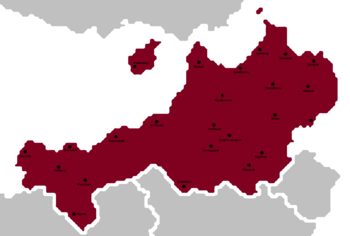 | |||||||||
| Capital | Westbrücken | ||||||||
| Common languages | Weranian | ||||||||
| Government | Federal single party national syndicalist totalitarian dictatorship | ||||||||
| Supreme Leader | |||||||||
• 1941-1942 | Dietrich zu Kolbenheyer | ||||||||
• 1942-1950 | Siegfried Höcker | ||||||||
• 1950 | Franz Rössler | ||||||||
| Legislature | Syndikatskammer | ||||||||
| History | |||||||||
| 17th June 1941 | |||||||||
| 17th December 1949 - 30th May 1950 | |||||||||
• Velvet Revolution | 14th May 1950 | ||||||||
| Currency | Mark | ||||||||
| |||||||||
| Today part of | |||||||||


